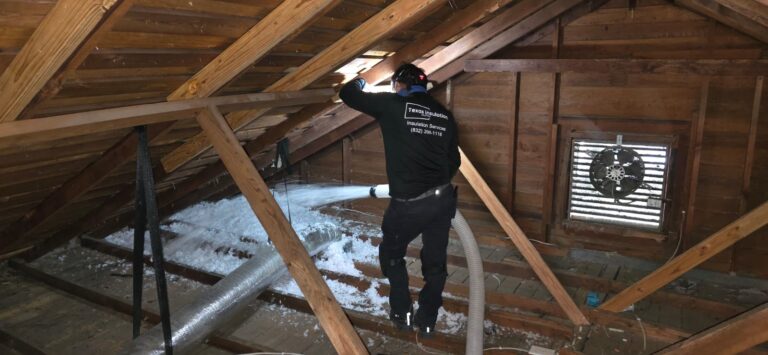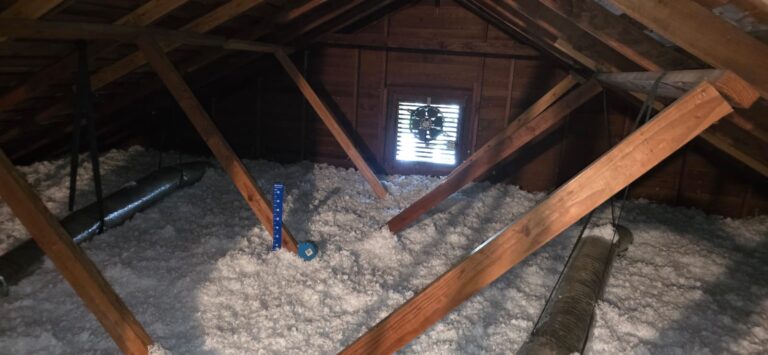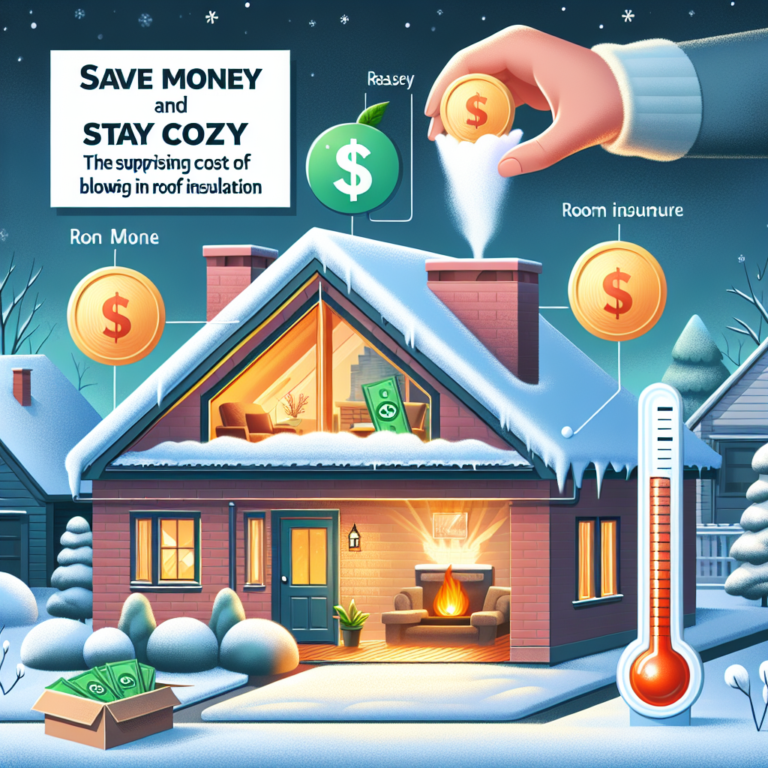-
Table of Contents
Go green and save money with sustainable blown-in insulation – the eco-friendly choice for reducing your carbon footprint.
Take a step towards reducing your carbon footprint and improving your home’s energy efficiency with sustainable blown-in insulation. Visit texasinsulationsolution.com to learn more and schedule an installation today.”
Introduction
Reducing our carbon footprint has become a crucial topic in today’s world as we strive towards a more sustainable future. One way to make a positive impact on the environment is by using sustainable blown-in insulation. This type of insulation not only helps to reduce energy consumption and lower utility bills, but it also minimizes the release of harmful greenhouse gases into the atmosphere. In this introduction, we will explore the benefits of sustainable blown-in insulation and how it can help us reduce our carbon footprint.
The Benefits of Sustainable Blown-In Insulation for Improving Home Efficiency
In today’s world, there is a growing concern about the impact of human activities on the environment. One of the major contributors to this issue is the excessive use of energy in our homes. As a result, many homeowners are looking for ways to reduce their carbon footprint and make their homes more energy-efficient. One solution that has gained popularity in recent years is sustainable blown-in insulation.
Sustainable blown-in insulation is a type of insulation made from recycled materials such as newspapers, cardboard, and denim. It is a cost-effective and environmentally friendly alternative to traditional insulation materials like fiberglass and foam. This type of insulation is installed by blowing it into walls, attics, and other spaces using specialized equipment. It is an excellent option for both new construction and existing homes.
One of the main benefits of sustainable blown-in insulation is its ability to improve home efficiency. By creating a thermal barrier, it helps to keep the warm air inside during the winter and the cool air inside during the summer. This reduces the need for heating and cooling, which in turn, reduces energy consumption and lowers utility bills. In fact, according to the Department of Energy, homeowners can save up to 20% on their heating and cooling costs by properly insulating their homes.
Moreover, sustainable blown-in insulation is also beneficial for the environment. As mentioned earlier, it is made from recycled materials, which means it reduces the amount of waste that ends up in landfills. This not only helps to conserve natural resources but also reduces the emission of greenhouse gases that contribute to climate change. Additionally, since this type of insulation is blown into place, it eliminates the need for cutting and fitting, which reduces the amount of energy and resources used during installation.
Another advantage of sustainable blown-in insulation is its ability to improve indoor air quality. Traditional insulation materials like fiberglass can release harmful particles into the air, which can cause respiratory problems and allergies. Sustainable blown-in insulation, on the other hand, is made from natural materials and does not contain any harmful chemicals. This makes it a safer and healthier option for both homeowners and the environment.
Furthermore, sustainable blown-in insulation is a long-lasting solution. Unlike traditional insulation materials that can settle and lose their effectiveness over time, blown-in insulation maintains its shape and R-value (a measure of insulation’s ability to resist heat flow) for many years. This means homeowners do not have to worry about replacing or adding more insulation in the future, saving them time and money.
In addition to its practical benefits, sustainable blown-in insulation also adds value to a home. With the increasing demand for eco-friendly and energy-efficient homes, having sustainable insulation can make a property more attractive to potential buyers. It also shows that the homeowner is environmentally conscious and takes steps to reduce their carbon footprint.
In conclusion, sustainable blown-in insulation offers numerous benefits for homeowners looking to improve their home’s efficiency and reduce their carbon footprint. It is a cost-effective, environmentally friendly, and long-lasting solution that can also improve indoor air quality and add value to a home. With its many advantages, it is no wonder that more and more homeowners are choosing this type of insulation for their homes. So, if you want to make your home more energy-efficient and contribute to a greener planet, consider sustainable blown-in insulation for your next insulation project.
How to Reduce Your Carbon Footprint with Sustainable Blown-In Insulation
In today’s world, there is a growing concern about the impact of human activities on the environment. One of the major contributors to this issue is the excessive use of energy, which leads to the emission of harmful greenhouse gases. As individuals, we have a responsibility to reduce our carbon footprint and make sustainable choices in our daily lives. One way to do this is by using sustainable blown-in insulation in our homes.
Blown-in insulation, also known as loose-fill insulation, is a type of insulation that is made up of small particles of materials such as cellulose, fiberglass, or mineral wool. It is installed by blowing the particles into the desired space, filling up any gaps and creating a barrier against heat loss. This type of insulation is becoming increasingly popular due to its many benefits, including its sustainability.
One of the main advantages of blown-in insulation is its ability to reduce energy consumption. By creating a barrier against heat loss, it helps to keep our homes warm in the winter and cool in the summer. This means that we can rely less on heating and cooling systems, which are major contributors to carbon emissions. By reducing our energy consumption, we can significantly decrease our carbon footprint and help combat climate change.
Moreover, blown-in insulation is made from sustainable materials, making it an environmentally friendly choice. Cellulose, one of the most commonly used materials in blown-in insulation, is made from recycled paper products, such as newspapers and cardboard. This means that it not only reduces waste but also reduces the need for new materials to be produced. Additionally, cellulose insulation is treated with borate, a natural mineral that acts as a fire retardant and insect repellent, eliminating the need for harmful chemicals.
Another sustainable material used in blown-in insulation is mineral wool, which is made from natural rock or slag. This material is non-toxic and does not release any harmful chemicals into the environment. It is also a byproduct of other industries, making it a sustainable choice for insulation. Fiberglass, although not as sustainable as cellulose or mineral wool, is still a better option than traditional insulation materials such as foam, which is made from petroleum-based products.
In addition to its sustainability, blown-in insulation also has a longer lifespan compared to other types of insulation. It does not settle or compress over time, meaning it will maintain its effectiveness for many years. This eliminates the need for frequent replacements, reducing waste and the use of new materials. Furthermore, blown-in insulation is also mold and pest resistant, ensuring a healthier and more sustainable living environment.
Installing blown-in insulation is a relatively simple process that can be done by a professional or as a DIY project. The insulation is blown into the desired space using specialized equipment, ensuring that every nook and cranny is filled. This creates a more airtight seal, reducing the amount of energy needed to heat or cool our homes. It is also a cost-effective option, as it requires less material and labor compared to other types of insulation.
In conclusion, reducing our carbon footprint is crucial in the fight against climate change, and using sustainable blown-in insulation is a simple yet effective way to do so. By reducing energy consumption, using sustainable materials, and having a longer lifespan, blown-in insulation is a sustainable choice for our homes. So, the next time you are considering insulation options, remember to choose blown-in insulation for a more sustainable and eco-friendly home.
Why Upgrading Your Insulation is Essential for a More Sustainable Home
In today’s world, the topic of sustainability is becoming increasingly important. As we become more aware of the impact our actions have on the environment, many of us are looking for ways to reduce our carbon footprint and live a more sustainable lifestyle. One area that often gets overlooked is the insulation in our homes. However, upgrading to sustainable blown-in insulation can have a significant impact on both the environment and our wallets.
First and foremost, let’s define what blown-in insulation is. It is a type of insulation that is made up of small particles of materials such as cellulose, fiberglass, or mineral wool. These particles are blown into the walls, attic, or other spaces in your home using a special machine. This method of insulation is becoming increasingly popular due to its effectiveness and sustainability.
One of the main benefits of blown-in insulation is its ability to reduce energy consumption. According to the U.S. Department of Energy, heating and cooling account for nearly half of the energy used in the average American home. By upgrading to blown-in insulation, you can significantly reduce the amount of energy needed to heat and cool your home. This is because blown-in insulation creates a tight seal, preventing air from escaping and keeping your home at a consistent temperature. As a result, your heating and cooling systems won’t have to work as hard, leading to lower energy bills and a reduced carbon footprint.
Another advantage of blown-in insulation is its eco-friendliness. Unlike traditional insulation materials, such as fiberglass, blown-in insulation is made from recycled materials. This means that it not only reduces waste but also reduces the need for new materials to be produced. Additionally, blown-in insulation is non-toxic and does not release harmful chemicals into the environment. This is especially important for those with respiratory issues or allergies, as traditional insulation materials can aggravate these conditions.
Furthermore, blown-in insulation is a long-term solution. Unlike other types of insulation that may need to be replaced every 10-15 years, blown-in insulation can last for up to 50 years. This means less waste and fewer resources being used to constantly replace insulation. Additionally, blown-in insulation is resistant to mold and pests, making it a more durable and sustainable option for your home.
In addition to its environmental benefits, blown-in insulation also has financial advantages. As mentioned earlier, it can significantly reduce your energy bills. This means that the initial cost of upgrading to blown-in insulation can be recouped over time through savings on your energy bills. Furthermore, blown-in insulation can increase the value of your home. With more and more homebuyers looking for sustainable features in their potential homes, having blown-in insulation can make your home more attractive to buyers and potentially increase its resale value.
Lastly, blown-in insulation is a versatile option for any home. It can be installed in both new and existing homes, making it a viable option for homeowners looking to upgrade their insulation. It can also be used in various areas of the home, including walls, attics, and crawl spaces. This versatility allows for a more comprehensive and effective insulation solution for your entire home.
In conclusion, upgrading to sustainable blown-in insulation is essential for a more sustainable home. It not only reduces energy consumption and lowers your carbon footprint but also has financial benefits and is a long-term solution. With its eco-friendliness, durability, and versatility, blown-in insulation is a smart choice for any homeowner looking to make their home more sustainable. So why wait? Start reducing your carbon footprint and saving money by upgrading to sustainable blown-in insulation today.
Q&A
Q: What is sustainable blown-in insulation?
A: Sustainable blown-in insulation is a type of insulation made from recycled materials, such as shredded newspaper or denim, that is blown into walls, attics, and other spaces to improve energy efficiency and reduce carbon emissions.
Q: How does blown-in insulation help reduce carbon footprint?
A: Blown-in insulation helps reduce carbon footprint by improving the energy efficiency of a building. It helps to keep the indoor temperature stable, reducing the need for heating and cooling, which in turn reduces the amount of energy and carbon emissions required to maintain a comfortable living space.
Q: Are there any other benefits to using sustainable blown-in insulation?
A: Yes, there are several other benefits to using sustainable blown-in insulation. It is non-toxic and does not contain harmful chemicals, making it safe for both the environment and human health. It also has a longer lifespan compared to traditional insulation materials, reducing the need for frequent replacements and further reducing waste and carbon emissions. Additionally, it can help reduce noise pollution and improve indoor air quality.
Conclusion
In conclusion, sustainable blown-in insulation is a highly effective and environmentally friendly solution for reducing carbon footprint. By using recycled materials and reducing energy consumption, this type of insulation helps to decrease the amount of greenhouse gas emissions and conserve natural resources. It also provides long-term energy savings for homeowners and businesses. By choosing sustainable blown-in insulation, individuals can make a positive impact on the environment and contribute to a more sustainable future.






